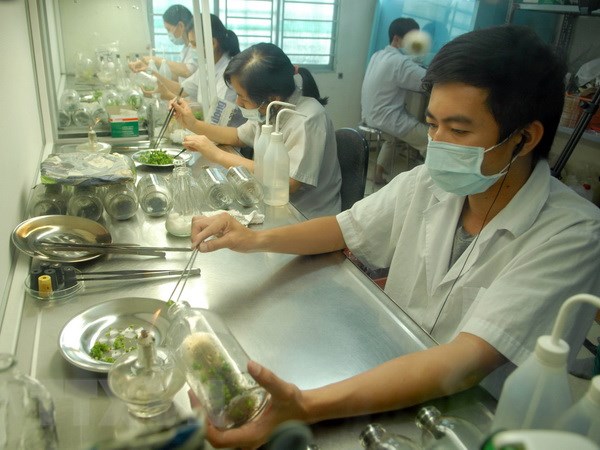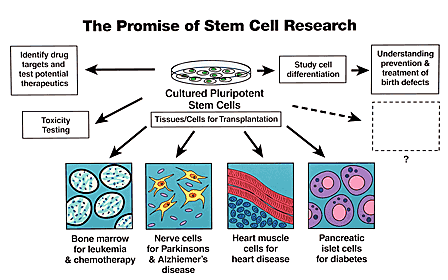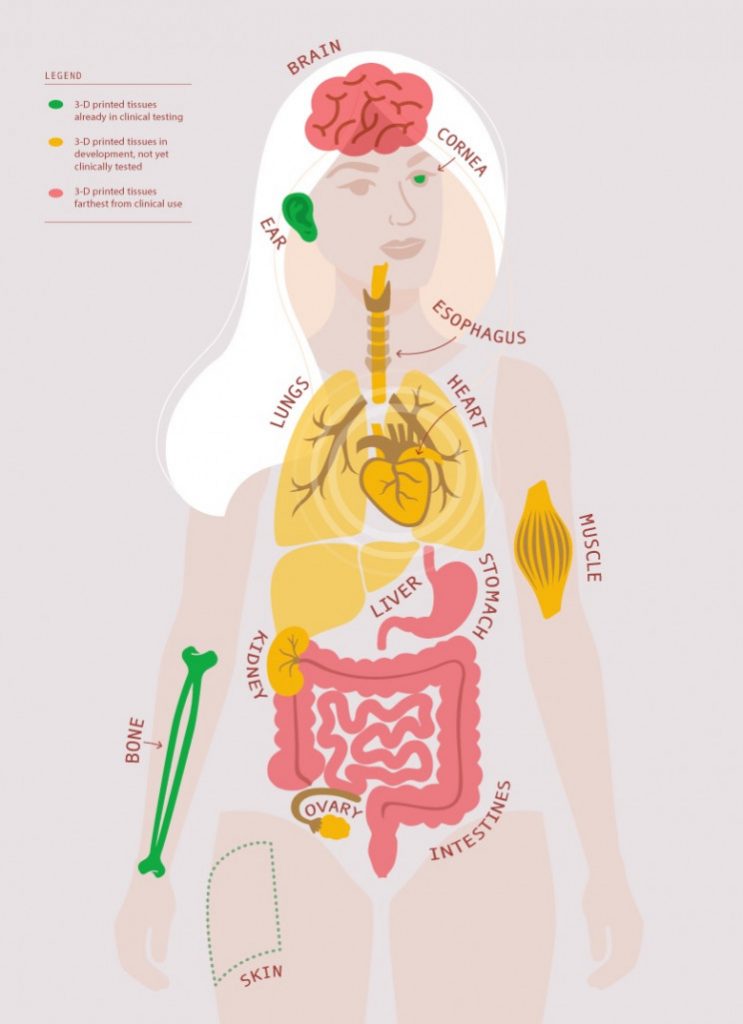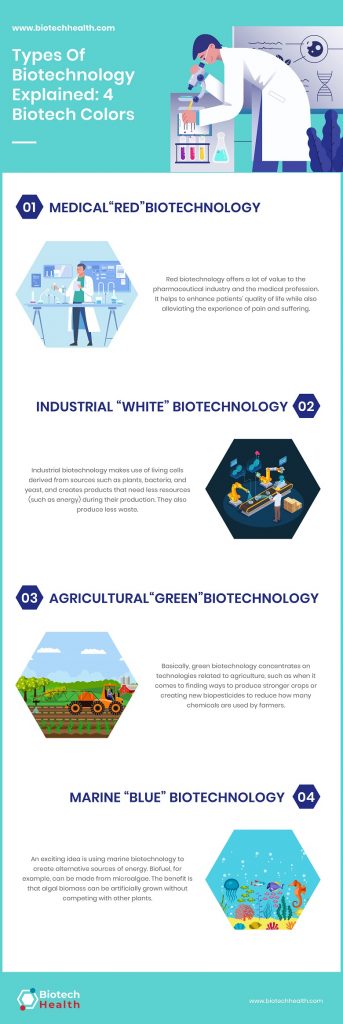The biotechnology industry is becoming a spearhead field of many countries. In Vietnam, the biotechnology industry is part of the science and technology development strategy from now to 2030 of the Ministry of Science and Technology, with more than 500 businesses and research centres in operation. The labour market in biotechnology is considered to have great potential for development both domestically and internationally.
What is Biotechnology?
Biotechnology is a high-tech, multidisciplinary field that integrates sciences and technologies such as biology, chemistry, physics, and process engineering to exploit living organisms to create products. products to serve people and develop socio-economic and protect the environment.
Essential applications of Biotechnology include:
- In medicine and pharmacy, it is the diagnosis of diseases by molecular methods, the creation of medicinal materials and the evaluation of quality…
- In agricultural production is to breed plants and animals, improve productivity by gene technology and cell technology..
- In industrial production is cleaning the environment by microbiological biotechnology, food processing, drug production, food …
What subjects do Biotechnology majors study?
By studying Biotechnology, students are equipped with:
- General knowledge as prescribed
- Basic knowledge of biology, in-depth understanding of experimental biology, molecular biology, microbial fermentation technology, applied plant tissue culture techniques, biopharmaceutical production technology and other technologies.
- In-depth knowledge in biotechnology such as biotechnology in medicine, biotechnology in agriculture, biotechnology in the environment, microbiology biotechnology, food biotechnology, aquaculture biotechnology…
- In addition, students are also equipped with skills such as communication skills, presentation skills, teamwork skills… to be able to work well in a dynamic environment.
What do you do with a degree in Biotechnology?
Graduates can work in a variety of positions:
- Research staff, technicians at regulatory agencies related to biology and biotechnology in many fields: agriculture, quality management, food safety, environment, health, pharmacy products, cosmetics.
- Engineer in charge of production, management and quality assurance at companies and enterprises in biotechnology.
- Experts for companies processing agricultural, food and seafood products; testing centres, laboratories, research institutions on microbiological technology, plant biotechnology, animal biotechnology.
- Sample analysis specialist; laboratory staff in hospitals, medical centres.
- Self-made, self-innovative to own and operate businesses in the field of biotechnology and other related fields such as: agriculture, food, plant varieties, fertilizers, feed.
- Teaching at universities, colleges.

Recent advances in Medicine and biotechnology
Stem Cell Research
Researchers grow stem cells in a lab. These stem cells are manipulated to specialize into specific types of cells, such as heart muscle cells, blood cells or nerve cells. The specialized cells can then be implanted into a person.
Have stem cells already been used to treat diseases?
Doctors have performed stem cell transplants, also known as bone marrow transplants. In stem cell transplants, stem cells replace cells damaged by chemotherapy or disease or serve as a way for the donor’s immune system to fight some types of cancer and blood-related diseases, such as leukaemia, lymphoma neuroblastoma and multiple myeloma. These transplants use adult stem cells or umbilical cord blood.

Targeted Cancer Therapies
Targeted cancer therapies are drugs or other substances that block the growth and spread of cancer by interfering with specific molecules (“molecular targets”) involved in the development, progression, and spread of cancer.
Face Transplants

A face transplant is a process of using skin grafts to replace all or a part of the patient’s face with a donor’s face.
Face donation involves a unique and sensitive consent process with donor families. In addition to matching blood type and immunological parameters like in solid organ transplantation, face donation involves a careful emphasis on matching skin colour, skin tone, gender, ethnicity, race and the size of the face and head.
Face Transplant Risks
As with any organ transplant, the most significant risk is that your body will regard your new limb as a foreign object, and your immune system will fight against it. With face transplants, rejection can appear as a rash that could be spotty, patchy or blotchy. It could appear anywhere on the face and is usually painless.
3D Printed Organs
Currently, the only organ that was 3D printed and successfully transplanted into a human is a bladder. The bladder was formed from the host’s bladder tissue. Researchers have proposed that a potential positive impact of 3D printed organs is the ability to customize organs for the recipient.
according to the National Foundation for Transplants, a standard kidney transplant, on average, costs upwards of $300,000, whereas a 3D bioprinter, the printer used to create 3D printed organs, can cost as little as $10,000

10-15 years before fully functioning tissues and organs printed in this way will be transplanted into humans
It is the lack of precision regarding droplet size and droplet placement compared to other bioprinting methods.
Brain Signals to Audible Speech
Scientists Use AI To Turn Brain Signals Into Speech: When you speak, your brain sends signals from the motor cortex to the muscles in your jaw, lips and larynx to coordinate their movement and produce a sound. They were asked to read aloud a list of sentences that the AI algorithm would read and decode the brain signals to their speech.
Results varied, however on average, the listeners could identify 70% of the words correctly. When given 25 options per word, they got 69% of the terms correct; with 50, they got 47% accurate.

The four main types of biotechnology are medical biotechnology (red), industrial biotechnology (white), environmental biotechnology (green), and marine biotechnology (blue).
Biotechnology is a trending career option. If you enjoy science, math, technology, investigating and solving problems, making valuable products.
From $70,000 to $100,000 per year for fresher.
Biotechnology is used to combat debilitating and rare diseases, reduce our environmental footprint, feed the hungry, use less clean energy, and have safer, cleaner and more efficient industrial manufacturing processes.


 Tiếng Việt
Tiếng Việt
Related posts: